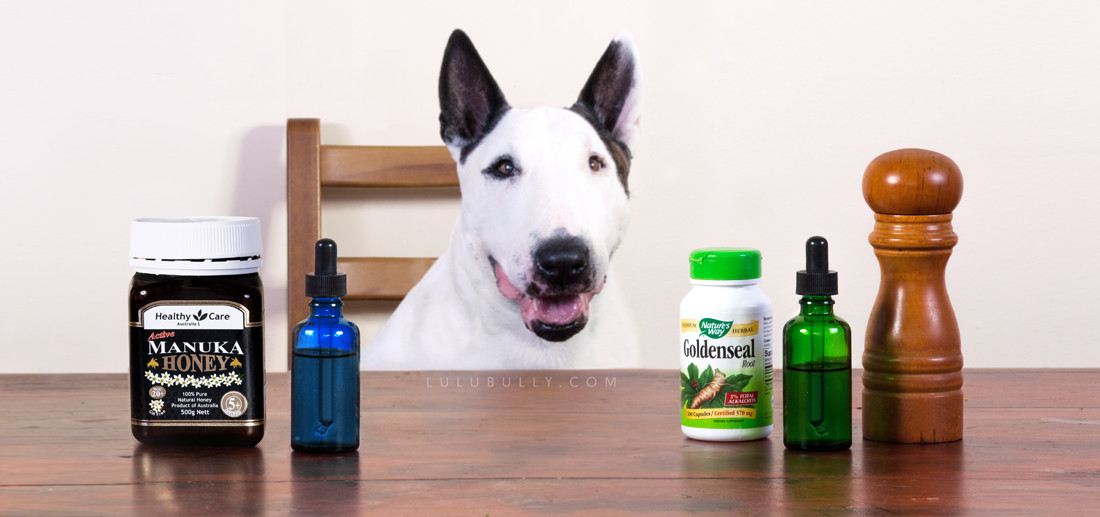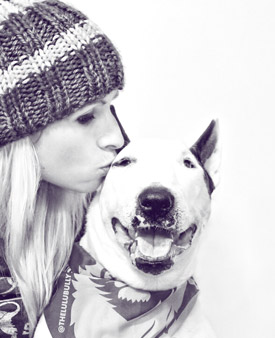HAPPY EYES
Does your dog ever get itchy eyes or have watery sore-looking eyes? These types of symptoms are really common for sensitive dogs like bull terriers, particularly during allergy seasons and in response to insect bites on the eyelids or around the eyes.
Lulu occasionally suffers from itchy eyes, particularly during summer or after visiting friends in the country where she’s in contact with multiple varieties of seeding grasses. Retail or prescription eye-drops designed for humans should never be used on your dog, but a pure saline solution is ok, and is useful for flushing allergens and other gunk from irritated eyes to provide a modicum of relief. More often than not, just flushing the eyes with saline isn’t enough to quell the effects of allergenic irritants, so I set out to find a natural a solution to these ocular itches by creating my own soothing, dog-safe eye drops.
I have two go-to recipes for soothing, healing natural eye drops – one that utilises the antimicrobial and near-magical properties of medicinal Manuka Honey (brilliant for conjunctivitis) and another that combines saline with the awesome anti-microbial and anti-allergenic properties of the medicinal herb goldenseal (great for allergenic itchy eyes). Both these two solutions have been fabulous for Lulu during itchy summers (and any other time she has irritated eyes).
RECIPES
One of the most important things to remember when making eye drops for dogs (or humans!) is to keep you work environment very clean and make sure that the pots, bowls and utensils you use and bottles you’re going to store the drops in are sterilised either in boiling water for about 5 minutes or in the oven at 120℃ for 10-15mins.
Manuka Honey Eye Drops
Inspired by Dr Andrew Jones, an holistic vet from Canada, I first made up some honey eye drops for Lulu after she copped conjunctivitis in one eye after a brief episode of seasonal allergies brought on by seeding grasses. I caught her rubbing the eye after coming back from visiting family in the country. With the change of environment the allergies cleared up on their own within 24hrs and the eye looked fine. But a few days later the eye was inflamed and oozy – just in that 24hr itchy period she must have rubbed enough undesirable bacterial characters in there to instigate a turf war. Re-inforcements were definitely necessary! Orders were sent to the Immuno Medical Honey Corps, post haste…
In his video Dr Jones uses plain Canadian runny ‘white’ unpasteurised field honey, mixing it 50/50 with water to make drops that he recommends for home treatment of conjunctivitis. Being from New Zealand, and growing up with Manuka honey both on the breakfast table and in many creams and ointments, my first thought was to go with what I know best and substitute the plain unpasteurised runny honey for Manuka honey (or as it’s now often called ‘Medicinal Manuka Honey’ since scientists found a way to quantify the ‘magic’ antimicrobial elements in the stuff I grew up eating on my toast and crumpets).
Medicated Manuka Honey is rated by the quantity of ‘Unique Manuka Factor’ or ‘UMF’ it contains. The greater the UMF written on the jar, the greater the antibacterial/antifungal properties and, correspondingly, the greater the price. For Lulu’s eyedrops I use UMF 5+, a relatively low UMF (a 250ml jar of which set me back $22) because as every Kiwi kid knows, a little Manuka honey goes a long way (and $50 for a jar of UMF 12+ is tumeke bro! Literally!). This 250ml jar of 5+ will probably last me about 3 years at the rate it takes to make these drops – $22 well spent!
The medicinal Manuka Honey is thicker (think a few degrees shy of cement) and darker than your common or garden, pale, runny table honey. The UMF rating also suggests that it’s packing some serious antimicrobial muscle compared to it’s table-top counterpart. So, I scaled down the ratio significantly from 50:50 to 1:15 – mixing half a tsp of Manuka Honey in 3 tbsp of luke warm water. Being so thick it takes longer to mix than running honey – I found that the best way to mix is in a sterilised jar (I just use an old coconut oil jar), adding the water and honey, doing the lid up tight and shaking it for about 5mins before decanting it into an awaiting sterilised dropper bottle. Even though the ratio is quite different, the resulting colour of the drops is very similar to Dr Jones 50:50 runny honey solution.
As with all these types of remedies, I tested the drops in my own eyes first. I was pleasantly surprised, having imagined that squeezing sugary water into my eyeballs couldn’t be particularly enjoyable experience, the drops felt lovely and immediately soothing. Lulu also seems to really enjoy them – possibly due to the fact that she’s worked out how to tilt her head at the perfect angle to get the overflowing drops to run into her mouth – she now starts licking her lips the moment I say “Honey drops?”.
The results of that first batch of drops were incredible – I put 2-3 drops in Lulu’s eye 3 times a day and the conjunctivitis cleared up in 3-4 days. I now always keep a fresh bottle of honey drops in the fridge and use them regularly any time I see even mild inflammation in either of Lulu’s eyes, or any rubbing, as a preventative measure. I also use them myself on tired, irritated or red eyes – they’re wonderful! They’ve replaced my old favourite Golden Seal and Saline drops (below) as my go-to eye remedy.
I always keep the drops in the fridge and keep each batch of drops for no more than 3 weeks. It’s important to take great care not to let the end of the drop come into contact with anything (fingers, eyes, fur, benches, anything), as you don’t want to be adding to the bacteria you’re trying to combat. If I know the dropper has touched something I discard the current solution, wash and re-sterilise the bottle and make a fresh batch to be on the safe side.
The Recipe:
1/2 tsp Manuka Honey UMF 5+
3 tbsp (45ml) Filtered water
Combine the honey with luke warm filtered water in a sterilised jar – shake until dissolved, then pour into a sterilised dropper bottle. Squeeze 2-3 drops 3 time daily into the affected eye as needed.


